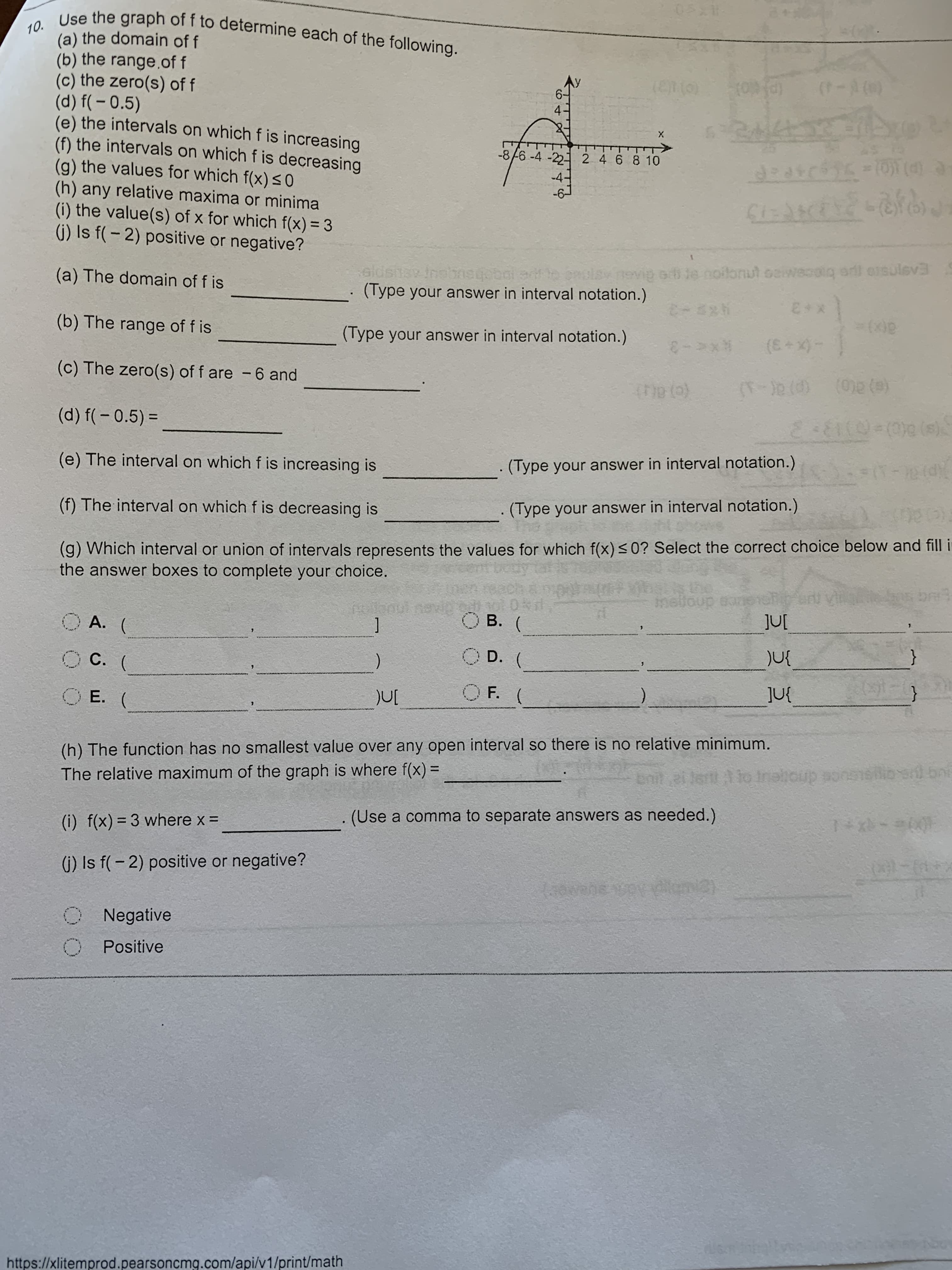Use the graph of f to determine each of the following. 10. (a) the domain of f (b) the range of f (c) the zero(s) of f (d) f(-0.5) (e) the intervals on which f is increasing (f) the intervals on which f is decreasing (g) the values for which f(x) s0 (h) any relative maxima or minima (i) the value(s) of x for which f(x) 3 (j) Is f(-2) positive or negative? (1(0) (et (O d) 6- > -8-6-4-22 2 46 8 10 -4- 67 CLEACE O) tidsnaw ing (Type your answer in interval notation.) pevig ad oilonut saiweoolg adl orsulsva (a) The domain of f is ES * C-s2N (b) The range of f is 0op (Type your answer in interval notation.) (E+x (c) The zero(s) of f are 6 and (0e (9) ( tr (to) (d) f(-0.5)= 2:81 Cls) (e) The interval on which f is increasing is (Type your answer in interval notation.) (f) The interval on which f is decreasing is (Type your answer in interval notation.) (9) Which interval or union of intervals represents the values for which f(x) s 0? Select the correct choice below and fill i the answer boxes to complete your choice. pach & 05 OB. ( urd sloup so A. ( JU[ OD. ( C. )U{ ) ( O F. ( E. ( JU{ (h) The function has no smallest value over any open interval so there is no relative minimum. The relative maximum of the graph is where f(x) = unit Jug ponustsucedioteut (Use a comma to separate answers as needed.) (i) f(x) = 3 where x 14x)-960 () Is f(-2) positive or negative? Suet -tf7 0ene yov dhm@) Negative Positive ewww wwwww http://xlitemprod.pearsoncmg.com/api/v1/print/math
Addition Rule of Probability
It simply refers to the likelihood of an event taking place whenever the occurrence of an event is uncertain. The probability of a single event can be calculated by dividing the number of successful trials of that event by the total number of trials.
Expected Value
When a large number of trials are performed for any random variable ‘X’, the predicted result is most likely the mean of all the outcomes for the random variable and it is known as expected value also known as expectation. The expected value, also known as the expectation, is denoted by: E(X).
Probability Distributions
Understanding probability is necessary to know the probability distributions. In statistics, probability is how the uncertainty of an event is measured. This event can be anything. The most common examples include tossing a coin, rolling a die, or choosing a card. Each of these events has multiple possibilities. Every such possibility is measured with the help of probability. To be more precise, the probability is used for calculating the occurrence of events that may or may not happen. Probability does not give sure results. Unless the probability of any event is 1, the different outcomes may or may not happen in real life, regardless of how less or how more their probability is.
Basic Probability
The simple definition of probability it is a chance of the occurrence of an event. It is defined in numerical form and the probability value is between 0 to 1. The probability value 0 indicates that there is no chance of that event occurring and the probability value 1 indicates that the event will occur. Sum of the probability value must be 1. The probability value is never a negative number. If it happens, then recheck the calculation.
Will someone help me with this problem? Subparts h,I,j

Trending now
This is a popular solution!
Step by step
Solved in 3 steps with 1 images









